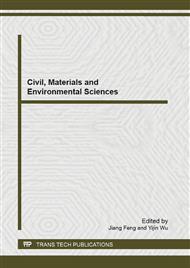[1]
Ministry of Housing and Urban-Rural Development. China Urban Construction Statistical Yearbook (China Planning Press, China 2012).
Google Scholar
[2]
B. Paul and R. Helmut. Practical handbook of material flow analysis (CRC Press, U.S. 2004).
Google Scholar
[3]
L. Liebig and L. Playfair. Chemistry in its application to agriculture and physiology (Wiley and Putnam Press, U.S. 1847).
Google Scholar
[4]
T. E. Graedel, D. van Beer, M. Bertram, et al: Environmental Science and Technology, Vol. 39 (2005), p.7060.
Google Scholar
[5]
J. Johnson,L. Schewel, and T. E, Graedel: Environmental Science and Technology, Vol. 44 (2010), p.4657.
Google Scholar
[6]
H. Ma, K. Matsubae, K. Nakajima, et al: Resources, Conservation and Recycling, Vol. 56 (2011), p.134.
Google Scholar
[7]
Z. Yuan, J. Shi,H. Wu, et al: Journal of Environmental Management, Vol. 92 (2011), p. (2012).
Google Scholar
[8]
A. Elshkaki, E. van Voet,M. Van Holderbeke, et al: Resources, Conservation and Recycling, Vol. 42 (2004), p.133.
DOI: 10.1016/j.resconrec.2004.02.008
Google Scholar
[9]
H. Hatayama,I. Daigo, Y. Matsuno, et al: Environmental Science and Technology, Vol. 44 (2010), p.4657.
Google Scholar
[10]
Y. Matsuno,T. Hur, V. Fthenakis: Resources, Conservation and Recycling, Vol. 61 (2012), p.83.
Google Scholar
[11]
H. Hatayama, H. Yamada, I. Daigo, et al: Materials Transactions, Vol. 48 (2007, p.2518.
Google Scholar
[12]
S. Hashimoto,Y. Moriguchi, A. Saito, et al: Resources, Conservation and Recycling, Vol. 40 (20104), p.201.
Google Scholar
[13]
D. van Beers, and T. E. Graedel: Journal of Clean Production, Vol. 15 (2007), p.849.
Google Scholar
[14]
H. Tabayashi,I. Daigo, and Y. Matsuno: ISIJ International, Vol. 49 (2009), p.1256.
Google Scholar
[15]
X. Dong, J. N. Chen, S. Y. Zeng,P. F. Du: Water & Wastewater Engineering, Vol. 37 (2011), p.137. (in Chinese).
Google Scholar
[16]
L. Benedetti, G. Drickx, D. Bixio, et al: Journal of Urban Water, Vol. 3 (2006), p.33.
Google Scholar
[17]
N. Chevre,C. Guignard,L. Rossi, et al: Water Science and Technology, Vol. 63 (2011), p.1341.
Google Scholar
[18]
China Meteorological Administration. http: /cdc. cma. gov. cn/home. do.
Google Scholar
[19]
G. Y. Zhang, H. Zhang, C. J. Yang, et al: Urban Environment & Urban Ecology, Vol. 21 (2008), p.18. (in Chinese).
Google Scholar
[20]
H. Y. Gan,M. N. Zhou,D. Q. Li, et al: Ecology and Environment, Vol. 15 (2006), p.969. (in Chinese).
Google Scholar
[21]
J. Zhang: China water & wastewater, Vol. 26 (2010), p.58. (in Chinese).
Google Scholar
[22]
S. F. Chen,L. J. Liu,Q. W. Zhang, et al: Journal of Shandong Jianzhu University, Vol. 27 (2012), p.80. (in Chinese).
Google Scholar
[23]
G. R. Huang, andT. F. Nie: Journal of South China University of Technology (Nature Science Edition), Vol. 40 (2012), p.142. (in Chinese).
Google Scholar
[24]
W. S. Xin. Engineering design and full-scale test of Jinan Xingji river wastewater treatment plant. Xi'an: Xi'an University of Architecture and Technology. 2006. (in Chinese).
Google Scholar
[25]
Y. W. Zhou, andH. B. Zhao. Theories and calculations of urban drainage network(China Architecture & Building Press, China 2000). (in Chinese).
Google Scholar
[26]
X. J. Zhang, andX. Huang. Principle and technology of water and wastewater physio-chemical treatment. (Tsinghua University Press, China 2011). (in Chinese).
Google Scholar
[27]
GB/T 18920-2002, Water quality standard for urban miscellaneous water consumption. (in Chinese).
Google Scholar
[28]
H. Y. Cao,S. B. Huang,J. Y. Li, et al: Journal of Water Resource & Water Engineering, Vol. 22 (2011), p.66. (in Chinese).
Google Scholar
[29]
X. Dong,P. F. Du, Z. Y. Li, et al: Environmental Science, Vol. 29 (2008), p.607. (in Chinese).
Google Scholar
[30]
T. Sui. Analysis of potential of rainwater utilization in urban area of Jinan. Jinan: Shandong Jianzhu University. 2008. (in Chinese).
Google Scholar


